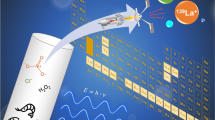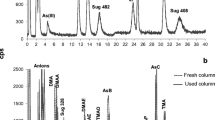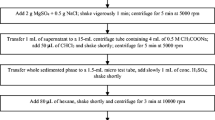Abstract
An accurate, ultra-sensitive and robust method for speciation of mono, di, and tributyltin (MBT, DBT, and TBT) by speciated isotope-dilution gas chromatography–inductively coupled plasma-mass spectrometry (SID-GC–ICPMS) has been developed for quantification of butyltin concentrations in cryogenic biological materials maintained in an uninterrupted cryo-chain from storage conditions through homogenization and bottling. The method significantly reduces the detection limits, to the low pg g−1 level (as Sn), and was validated by using the European reference material (ERM) CE477, mussel tissue, produced by the Institute for Reference Materials and Measurements. It was applied to three different cryogenic biological materials—a fresh-frozen mussel tissue (SRM 1974b) together with complex materials, a protein-rich material (whale liver control material, QC03LH03), and a lipid-rich material (whale blubber, SRM 1945) containing up to 72% lipids. The commutability between frozen and freeze-dried materials with regard to spike equilibration/interaction, extraction efficiency, and the absence of detectable transformations was carefully investigated by applying complementary methods and by varying extraction conditions and spiking strategies. The inter-method results enabled assignment of reference concentrations of butyltins in cryogenic SRMs and control materials for the first time. The reference concentrations of MBT, DBT, and TBT in SRM 1974b were 0.92 ± 0.06, 2.7 ± 0.4, and 6.58 ± 0.19 ng g−1 as Sn (wet-mass), respectively; in SRM 1945 they were 0.38 ± 0.06, 1.19 ± 0.26, and 3.55 ± 0.44 ng g−1, respectively, as Sn (wet-mass). In QC03LH03, DBT and TBT concentrations were 30.0 ± 2.7 and 2.26 ± 0.38 ng g−1 as Sn (wet-mass). The concentration range of butyltins in these materials is one to three orders of magnitude lower than in ERM CE477. This study demonstrated that cryogenically processed and stored biological materials are a promising alternative to conventional freeze-dried materials for organotin speciation analysis, because these are, at present, the best conditions for minimizing degradation of thermolabile species and for long-term archival. Finally, the potential of the analytical method was illustrated by analysis of polar bear (Ursus maritimus) and beluga whale (Delphinapterus leuca) liver samples that had been collected in the Arctic and archived at the Marine Environmental Specimen Bank. Significant concentrations of butyltin compounds were found in the samples and provide the first evidence of the presence of this class of contaminant in the Arctic marine ecosystem.

Eye catch image




Similar content being viewed by others
References
Ueno D, Inoue S, Takahashi S, Ikeda K, Tanaka H, Subramanian AN, Fillmann G, Lam PKS, Zheng J, Muchtar M (2004) Environ Pollut 127:1–12
Nishikawa Ji, Mamiya S, Kanayama T, Nishikawa T, Shiraishi F, Horiguchi T (2004) Environ Sci Technol 38:6271–6276
Wade TL, Garcia-Romero B, Brooks J (1988) Environ Sci Technol 22:1488–1493
Hai Le LT, Takahashi S, Saeki K, Nakatani N, Tanabe S, Miyazaki N, Fujise Y (1999) Environ Sci Technol 33:1781–1786
Encinar JR, Alonso JIG, Sanz-Medel A (2000) J Anal Atom Spectrom 15:1285
Encinar JR, Villar MIM, Santamaria VG, Alonso JIG, Sanz-Medel A (2001) Anal Chem 73:3174–3180
Monperrus M, Martin-Doimeadios RCR, Scancar J, Amouroux D, Donard OFX (2003) Anal Chem 75:4095–4102
Monperrus M, Zuloaga O, Krupp E, Amouroux D, Wahlen R, Fairman B, Donard OFX (2003) J Anal Atom Spectrom 18:247–253
Rodriguez-Gonzalez P, Marchante-Gayon JM, Alonso JIG, Sanz-Medel A (2005) Spectrochim Acta B 60:151–207
Yang L, Mester Z, Sturgeon RE (2003) Can J Anal Sci Spectrosc 48:211–218
Sturgeon RE, Wahlen R, Brandsch T, Fairman B, Wolf-Briche C, Alonso JIG, Gonzalez PR, Encinar JR, Sanz-Medel A, Inagaki K, Takatsu A, Lalere B, Monperrus M, Zuloaga O, Krupp E, Amouroux D, Donard OFX, Schimmel H, Sejeroe-Olsen B, Konieczka P, Schultze P, Taylor P, Hearn R, Mackay L, Myors R, Win T, Liebich A, Philipp R, Yang L, Willie S (2003) Anal Bioanal Chem 376:780–787
Quevauvillier P, Morabito R, Ebdon L, Cofino W, Muntau H, Campbell MJ (1997) IRMM: Luxembourg
Shawky S, Emons H (1998) Chemosphere 36:523–535
Emons H, Schladot JD, Schwuger MJ (1997) Chemosphere 34:1875–1888
Zeisler R, Langland JK, Harrison SH (1983) Anal Chem 55:2431–2434
Wise SA, Benner BA, Christensen RG, Koster BJ, Kurz J, Schantz MM, Zeisler R (1991) Environ Sci Technol 25:1695–1704
Wise SA, Schantz MM, Koster BJ, Demiralp R, Mackey EA, Greenberg RR, Burow M, Ostapczuk P, Lillestolen TI (1993) Fresenius J Anal Chem 345:270–277
Schantz MM, Koster BJ, Oakley LM, Schiller SB, Wise SA (1995) Anal Chem 67:901–910
Donais MK, Saraswati R, Mackey E, Demiralp R, Porter B, Vangel M, Levenson M, Mandic V, Azemard S, Horvat M, May K, Emons H, Wise S (1997) Fresenius J Anal Chem 358:424–430
Tutschku S, Schantz MM, Wise SA (2002) Anal Chem 74:4694–4701
Poster DL, Kucklick JR, Schantz MM, Porter BJ, Leigh SD, Wise SA (2003) Anal Bioanal Chem 375:223–241
Poster DL, Schantz MM, Kucklick JR, de Alda MJL, Porter BJ, Pugh R, Wise SA (2004) Anal Bioanal Chem 378:1213–1231
Rudel H, Lepper P, Steinhanses J (2003) Environ Sci Technol 37:1731–1738
ISO (1993) Guide to the expression of uncertainty in measurement
Eurachem (2000)
Schmitt VO, Szpunar J, Donard OFX, Lobinski R (1997) Can J Anal Sci Spectrosc 42:41–49
Pereiro IR, Schmitt VO, Szpunar J, Donard OFX, Lobinski R (1996) Anal Chem 68:4135–4140
Szpunar J, Schmitt VO, Lobinski R, Monod JL (1996) J Anal Atom Spectrom 11:193–199
Poperechna N, Heumann KG (2005) Anal Bioanal Chem 383:153–159
Rodriguez-Gonzalez P, Alonso JIG, Sanz-Medel A (2004) J Anal Atom Spectrom 19:767–772
Yu LL, Fassett JD, Guthrie WF (2002) Anal Chem 74:3887–3891
Centineo G, Rodriguez-Gonzalez P, Gonzalez EB, Alonso JIG, Sanz-Medel A (2004) J Mass Spectrom 39:485–494
Rodríguez-González P, Ruiz Encinar J, Ignacio García Alonso J, Sanz-Medel A (2004) J Anal Atom Spectrom 19:685–691
Levenson MS, Banks DL, Eberhardt KR, Gill LM, Guthrie WF, Liu HK, Vangel MG, Yen JH, Zhang NF (2000) J Res National Inst Stan Technol 105:571–579
Acknowledgements
The authors acknowledge LGC Ltd (Teddington, UK) for providing the enriched TBT and DBT standard as part of an international intercomparison exercise. The development of the marine mammal SRMs and control materials and the Marine ESB samples used in this paper involved numerous individuals and organizations including the National Marine Fisheries Service’s Marine Mammal Health and Stranding Response Program, New England Aquarium, Wayne McFee of the National Oceanic and Atmospheric Administration, U.S. Geological Survey’s Alaska Science Center, North Slope Borough Department of Wildlife Management, and Todd O’Hara of the University of Alaska Fairbanks.
Author information
Authors and Affiliations
Corresponding author
Rights and permissions
About this article
Cite this article
Point, D., Davis, W.C., Christopher, S.J. et al. Development and application of an ultratrace method for speciation of organotin compounds in cryogenically archived and homogenized biological materials. Anal Bioanal Chem 387, 2343–2355 (2007). https://doi.org/10.1007/s00216-006-1099-5
Received:
Revised:
Accepted:
Published:
Issue Date:
DOI: https://doi.org/10.1007/s00216-006-1099-5




